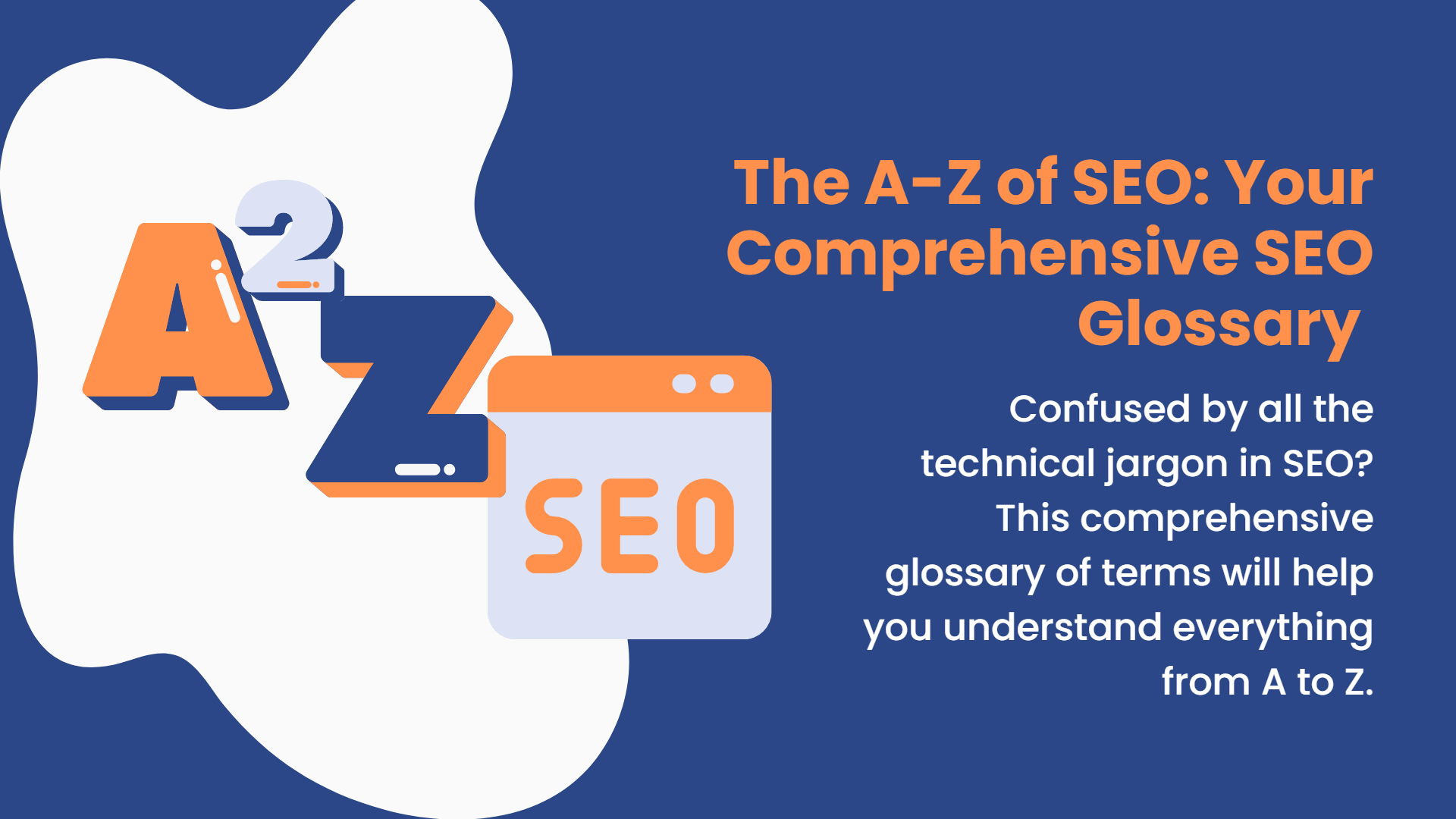Early on, websites were built solely based on the knowledge of markup languages. This widespread practice made it difficult for anyone to interpret source codes, manage a site, and run diagnostics in case of render or functionality errors. Since then, developers have adopted semantic HTML5 and CSS3 standards that encourage consistency and readability among web development teams.
Semantics helps break down information into smaller components, allowing anyone coder to understand what those functions stand for. In this guide, you’ll learn about semantic HTML and how to use it properly as a coder.
What Is Semantic HTML?
Semantic, by definition – relates to language or logic. In this context, semantic HTML is a method of using HTML to convey meanings to both machine analysis and human interpretation. It involves using HTML elements that describe the contents of a webpage in a generic and more meaningful way.
It involves using ethical web development practices, such as appropriate attributes in creating a well-structured source code document.
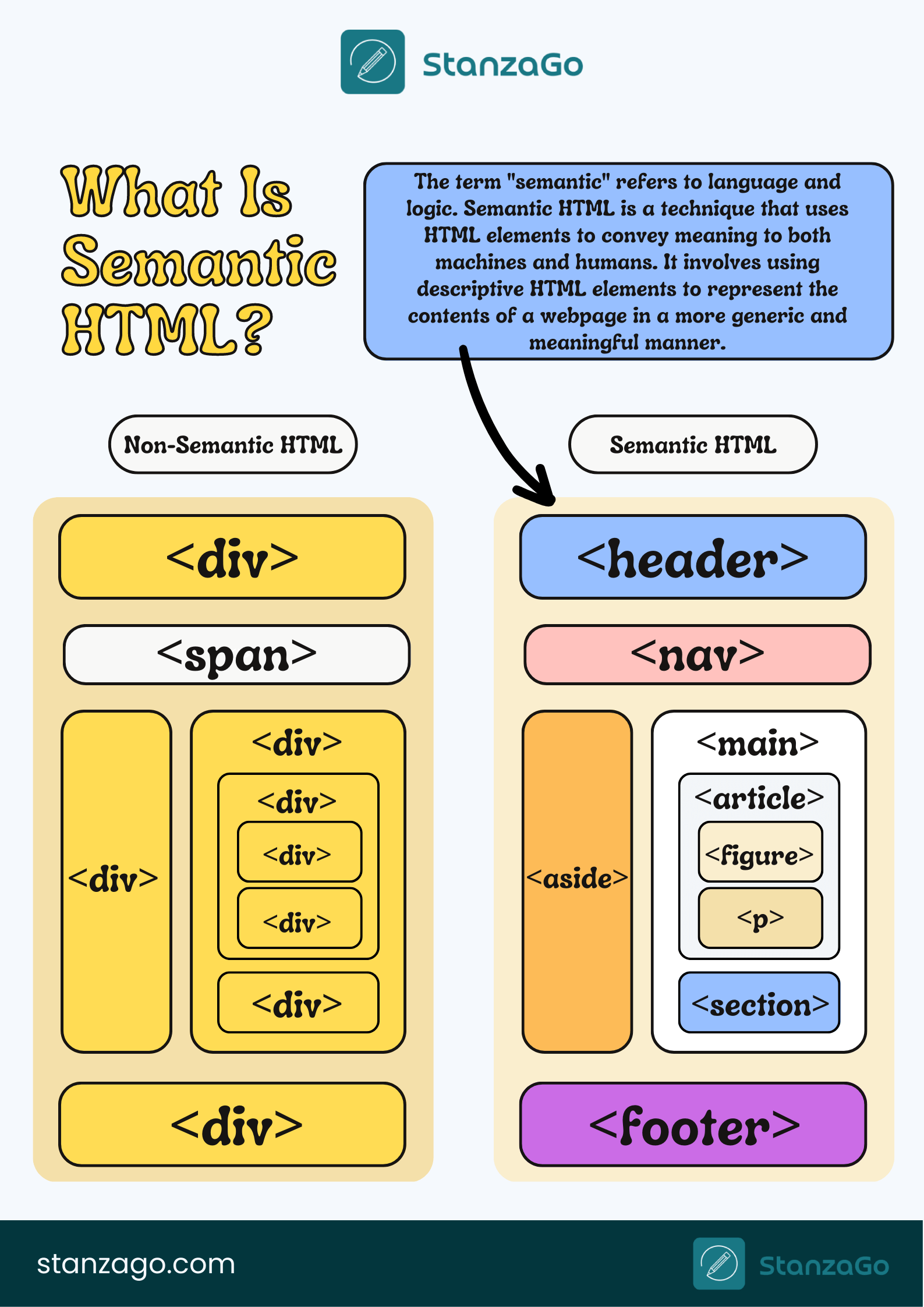
Semantic HTML relies on Semantic HTML tags like <p> tags to indicate the start of a paragraph, <head> tags for showing a content’s heading, <i> tags for italic text decoration, <ul> tags for an unordered list, <footer> tag for the end of a page, etc.
Semantic elements, unlike Semantic HTML Tags, are specific HTML elements that have been designed with semantic meaning in mind. These elements offer additional content and meaning to the content they are wrapped around, which makes it easier for search engines and assistive technologies to understand the purpose and structure of a webpage.
List of HTML Elements
Below is a short list of well-known Semantic HTML elements and tags:
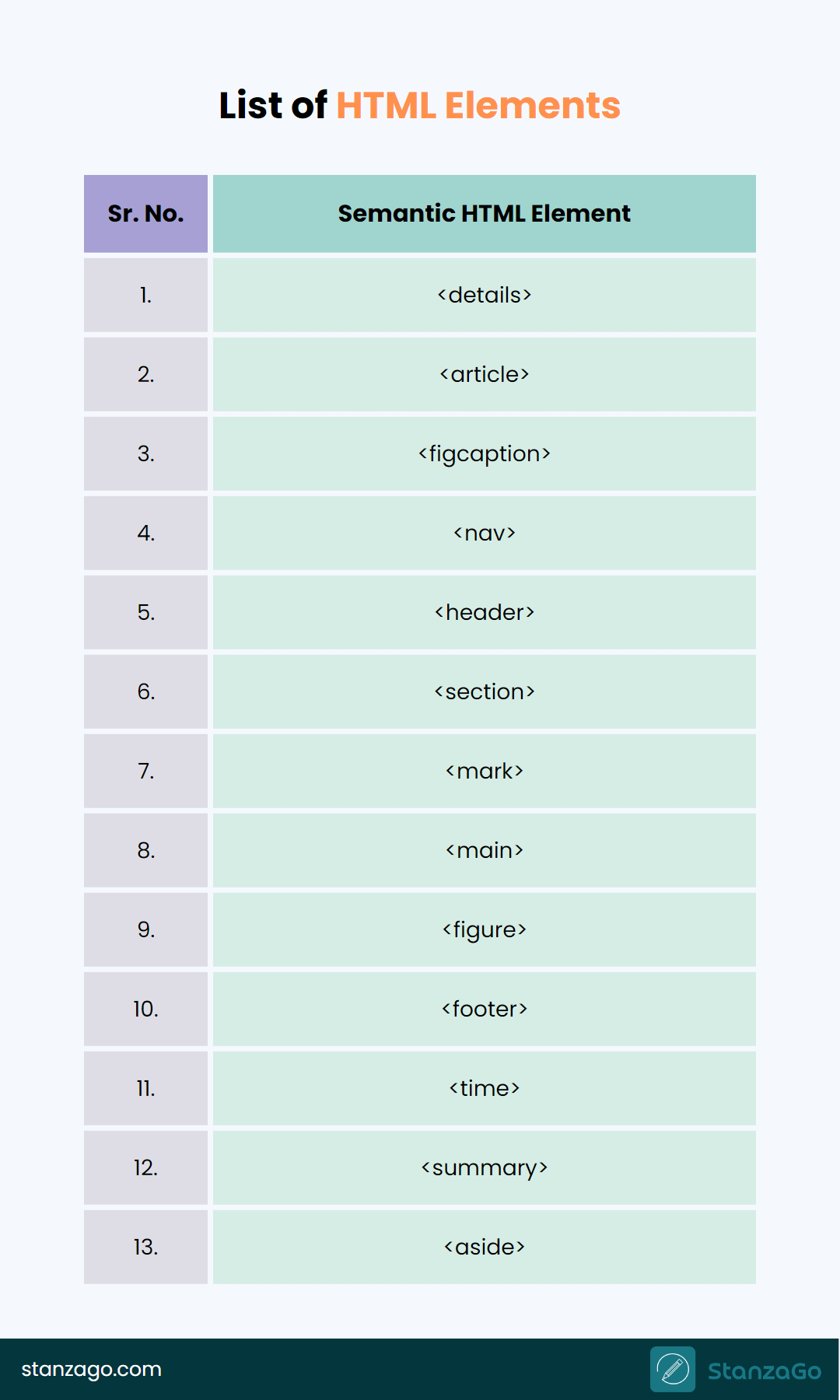
Why Is Semantic HTML So Important?
Apart from enhanced readability, the following are a few merits of semantic tag uses:
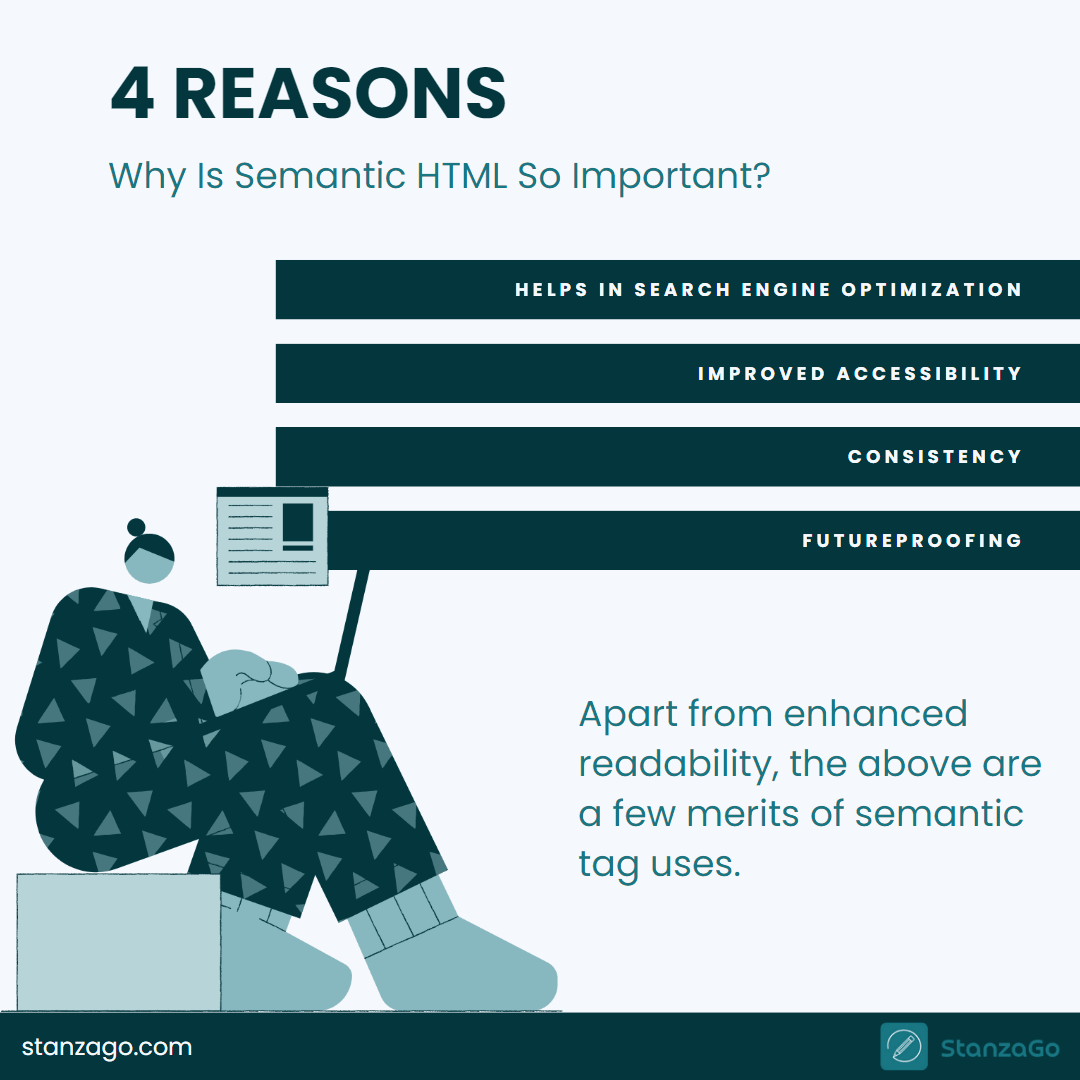
(1) Search Engine Optimization: To assess the relevance and ranking of online pages, search engines mainly rely on HTML markup. Web designers can boost a page’s visibility in search results by utilizing semantic tags to aid search engines in comprehending the content and context of the page.
(2) Accessibility: Semantic HTML provides context and structure to the material for assistive technologies like screen readers. Web designers may ensure that all users, regardless of abilities or impairments, can access the material by employing semantic tags.
(3) Consistency: Over time, semantic tags make it simpler to update and manage a website. Web developers may ensure the material is structured and ordered even as the page changes and evolves by employing consistent and useful tags.
(4) Futureproofing: Semantic tags provide a standard and consistent approach to describing the information, which makes it easier to adapt the website to new technologies and devices. For example, semantic tags can make it easier to construct responsive designs that adjust to different screen sizes and devices.
How to Use HTML Semantic Links
Semantic HTML, also known as structured or meaningful HTML, refers to using HTML tags that convey meaning and define the purpose of the content they enclose. Semantic HTML helps to create a clearer and more accessible website, making it easier for both users and search engines to understand the content. Here’s how to use semantic HTML effectively:
Here are a few steps to help you utilize Semantic HTML:
(1) Choose the appropriate Semantic HTML tags: The first step to using semantic HTML is choosing the best tags for your content. For example, use <h1> to open a page's headers. This indicates the main header as tagged number one. Use <p> for a paragraph of text, <nav> for the site’s navigation content, <header> tag for indicating the headings, and <section> tag to annotate each section.
(2) Use heading tags in order of sequence: As we mentioned earlier, heading tags <h1> extends up to <h6>, so keeping them organized and in line with your content is important. They should be used hierarchically, with the main heading being <h1>, followed by other numbers in descending numbers. Don’t use a heading just for styling; incorporate purpose for every use so your content gets a smooth body.\
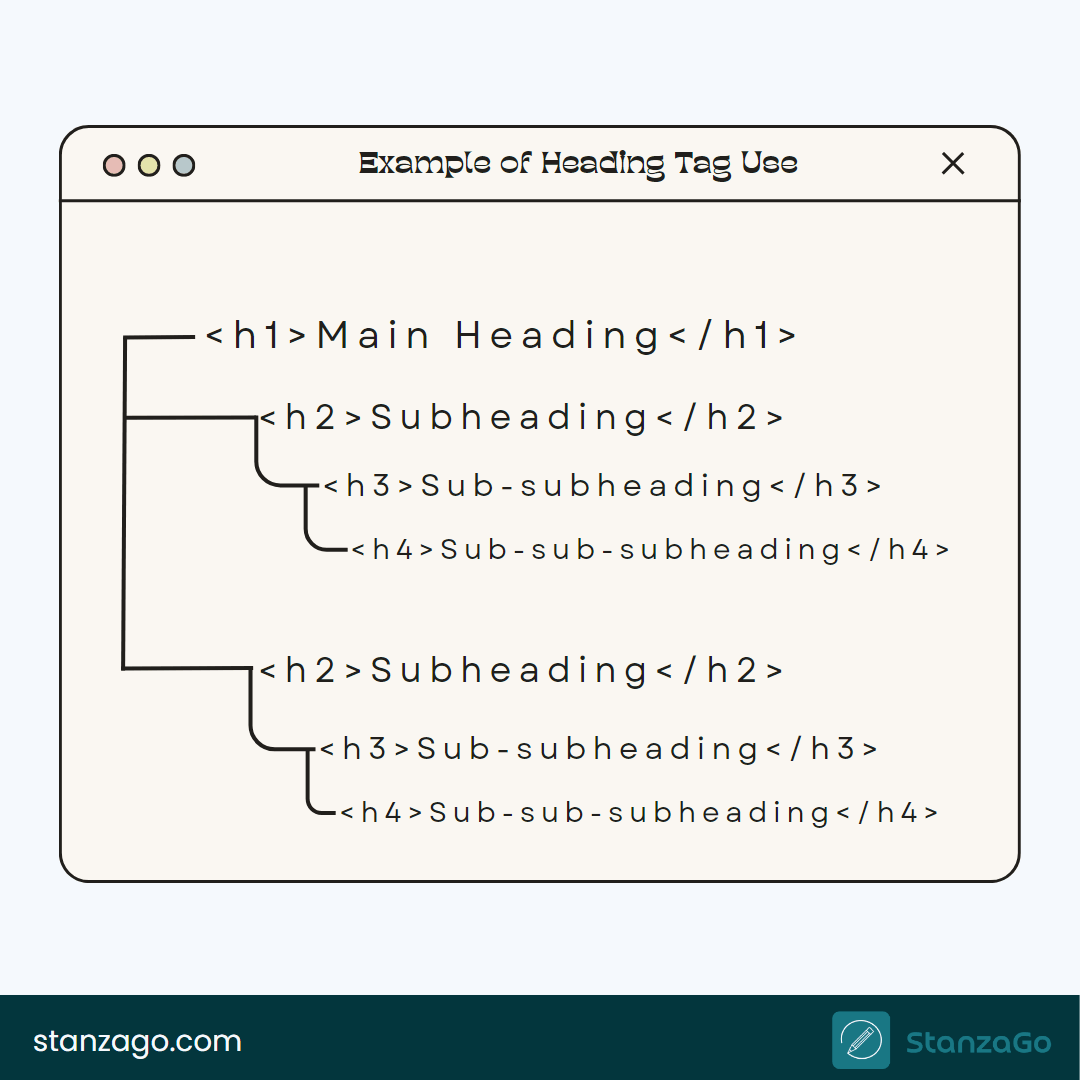
Example of heading tag use
<h1>Main Heading</h1>
<h2>Subheading</h2>
<h3>Sub-subheading</h3>
<h4>Sub-sub-subheading</h4>
<h5>Sub-sub-sub-subheading</h5>
<h6>Sub-sub-sub-sub-subheading</h6>
(3) Utilize the <ul> unordered and ordered <ol> tags. This list can help organize content and make it more easily understood from both the back and front ends. It also allows WebCrawler to rank your site's content as a list or HTML carousel data sets.
Here is a short example:
----- Unordered List -----
<ul>
<li>Item 1</li>
<li>Item 2</li>
<li>Item 3</li>
</ul>
In this case, <ul> assigns a bullet point or custom images to each listed item.
----- Ordered List ------
<ol>
<li>First item</li>
<li>Second item</li>
<li>Third item</li>
</ol>
In this case, <ol> assigns a character set to each listed item.
(4) Use descriptive alt attributes: Traditionally, programmers assign alt attributes to images or external or internal media files. This will help visually impaired users understand the content and assist search engines to what the image is about. Alts can help programmers trace image source links from the backend.
(5) Use <div> and <span> only for content with a specific meaning or function. Avoid using non-semantic tags for content to make the material more precise and more understandable; use semantic tags instead.
(6) Use the aria-label properties to give more information about elements that may not be obvious from the content alone.
(7) Keep it simple: Use only the essential tags to convey the meaning of the content; otherwise, your markup will be difficult to read and manage.
(8) Increased Accessibility: You may increase the usability and accessibility of your website for all users, including those with disabilities, by adopting semantic HTML. Additionally, by making it simpler for search engines to grasp the content of your website, it can help with search engine optimization (SEO). Keep it straightforward and utilize only the necessary tags to communicate the content’s meaning.
Semantic Links
Semantic links are key to better Search Engine Optimization for both a website and its content. Semantic links use descriptive and meaningful text to provide additional context and information about the target page. As each web developer attaches metadata elements to a site’s content, semantic linking helps connect metadata elements.
While semantic linking is focused on using descriptions and text links to provide context and information, meta elements provide tag-like details about the website or webpage, aiding search engines to crawl a site’s content better.
Example of an HTML Page Using Semantic HTML5 Tags, Semantic Links, and Metadata
<!DOCTYPE html>
<html lang="en">
<head>
<meta charset="UTF-8">
<meta name="viewport" content="width=device-width, initial-scale=1.0">
<meta name= “description” content=” Example website using semantic links and metadata elements”>
<meta name= “keywords” content= “semantic links, metadata elements, web development”>
<meta name="author" content="John Doe">
<title>Example Website</title>
</head>
<body>
<header>
<nav>
<ul>
<li><a href="/" class="active">Home</a></li>
<li><a href="/about">About Us</a></li>
<li><a href="/services">Our Services</a></li>
<li><a href="/blog">Blog</a></li>
<li><a href="/contact">Contact Us</a></li>
</ul>
</nav>
</header>
<main>
<h1>Welcome to Example Website</h1>
<p>We are a web development company specializing in using semantic links and metadata elements to create optimized and user-friendly websites. </p>
<h2>About Us</h2>
<p>Learn more about our company and our mission to provide high-quality web development services. </p>
<a href="/about" class="btn">Learn More</a>
<h2>Our Services</h2>
<ul>
<li><a href="/services/web-design">Web Design</a></li>
<li><a href="/services/web-development">Web Development</a></li>
<li><a href="/services/SEO">Search Engine Optimization</a></li>
<li><a href="/services/social-media">Social Media Marketing</a></li>
</ul>
<h2>Latest Blog Posts</h2>
<ul>
<li><a href="/blog/post1">Post 1: The Importance of Semantic Links</a></li>
<li><a href="/blog/post2">Post 2: Using Metadata Elements for Better SEO</a></li>
<li><a href="/blog/post3">Post 3: The Future of Web Development</a></li>
</ul>
</main>
<footer>
<p>© 2023 Example Website. All rights reserved. </p>
</footer>
</body>
</html>
Conclusion
In conclusion, semantic HTML is an essential aspect of web development. It allows developers to create web pages with meaningful and organized content, which can improve the user experience and accessibility of the website. By using semantic HTML tags, developers can make it easier for search engines to understand the web page's content, which can improve the website’s search engine ranking.




